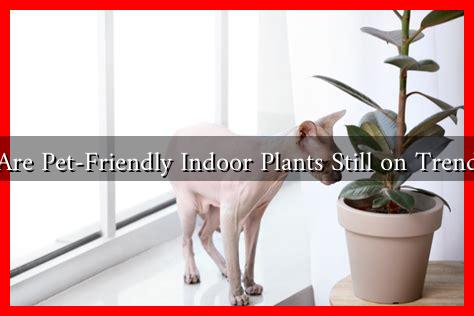-
Table of Contents
Are Pet-Friendly Indoor Plants Still on Trend?
In recent years, the trend of incorporating indoor plants into home decor has surged, with pet owners particularly keen on finding options that are safe for their furry friends. As we delve into 2023, the question arises: are pet-friendly indoor plants still on trend? This article explores the current landscape of pet-friendly plants, their benefits, and how they fit into modern home aesthetics.
The Rise of Pet-Friendly Plants
The growing awareness of the importance of indoor plants for mental and physical well-being has led to a significant increase in their popularity. According to a report by the National Gardening Association, 35% of households in the U.S. now include indoor plants, with a notable portion being pet owners. This trend is fueled by the desire to create a harmonious living environment that accommodates both pets and plants.
Why Choose Pet-Friendly Plants?
Pet-friendly plants are not just a trend; they are a necessity for many households. Here are some compelling reasons to choose them:
- Safety: Many common houseplants are toxic to pets. Choosing pet-friendly options ensures the safety of your furry companions.
- Health Benefits: Indoor plants can improve air quality, reduce stress, and enhance mood, benefiting both pets and their owners.
- Aesthetic Appeal: Pet-friendly plants can add beauty and vibrancy to your home without compromising safety.
Popular Pet-Friendly Indoor Plants
As the trend continues, several pet-friendly plants have emerged as favorites among pet owners. Here are some of the most popular options:
- Spider Plant (Chlorophytum comosum): Known for its air-purifying qualities, the spider plant is non-toxic to pets and easy to care for.
- Bamboo Palm (Chamaedorea seifrizii): This attractive palm not only enhances indoor aesthetics but is also safe for pets.
- Boston Fern (Nephrolepis exaltata): A lush, green option that thrives in humidity, the Boston fern is non-toxic and pet-friendly.
- Ponytail Palm (Beaucarnea recurvata): This unique plant is not only safe for pets but also requires minimal maintenance.
- Areca Palm (Dypsis lutescens): Another great air purifier, the areca palm is safe for both cats and dogs.
Case Studies: Pet Owners Embracing Indoor Plants
Several case studies highlight the trend of pet owners incorporating indoor plants into their homes. For instance, a survey conducted by the American Society for the Prevention of Cruelty to Animals (ASPCA) found that 60% of pet owners have made a conscious effort to choose non-toxic plants. Many reported that their pets enjoy the presence of greenery, often using them as playful elements in their environment.
Another case study from a popular home decor blog revealed that pet owners who introduced plants into their living spaces reported a 40% increase in overall satisfaction with their home environment. This satisfaction stemmed from both the aesthetic appeal of the plants and the peace of mind that came from knowing their pets were safe.
Current Trends in Pet-Friendly Plant Decor
As we move through 2023, several trends are emerging in the realm of pet-friendly indoor plants:
- Vertical Gardens: Many pet owners are opting for vertical gardens, which save space and keep plants out of reach of curious pets.
- Hanging Planters: These are becoming increasingly popular, allowing for creative displays while keeping plants safe from pets.
- Plant Shelves: Dedicated plant shelves are being designed to showcase pet-friendly plants, adding a stylish touch to home decor.
Conclusion
In conclusion, pet-friendly indoor plants are not only still on trend but are also becoming an essential part of pet owners’ lifestyles. With a growing awareness of the importance of safety and well-being, more people are choosing plants that enhance their living spaces while ensuring their pets remain safe. The variety of options available today allows for creativity in home decor, making it easier than ever to create a pet-friendly oasis. As we continue to embrace the benefits of indoor plants, it’s clear that this trend is here to stay.
For more information on pet-friendly plants, you can visit the ASPCA’s guide on toxic and non-toxic plants.

